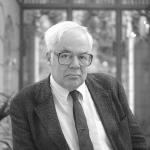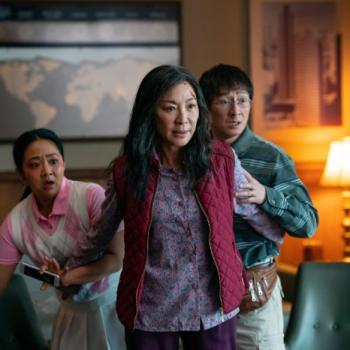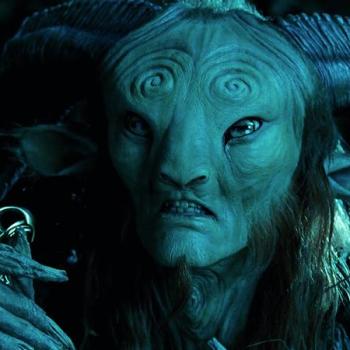 Like so many other longstanding fictional characters, James Bond has always been a man of his times, evolving with the mores and anxieties of the contemporary age. He might’ve gotten his start battling Communists, but certainly hasn’t stopped there. After the fall of the Soviet Union, the Pierce Brosnan era pitted Bond against the enemies of a decidedly neoliberal culture—a magnate who manipulates the news (Tomorrow Never Dies), an ex-KGB agent turned terrorist (The World Is Not Enough), murderous North Koreans (Die Another Day) and so on.
Like so many other longstanding fictional characters, James Bond has always been a man of his times, evolving with the mores and anxieties of the contemporary age. He might’ve gotten his start battling Communists, but certainly hasn’t stopped there. After the fall of the Soviet Union, the Pierce Brosnan era pitted Bond against the enemies of a decidedly neoliberal culture—a magnate who manipulates the news (Tomorrow Never Dies), an ex-KGB agent turned terrorist (The World Is Not Enough), murderous North Koreans (Die Another Day) and so on.
But the Daniel Craig quintet—which began with Casino Royale (2006) and continued through Quantum of Solace (2008), Skyfall (2012), Spectre (2015), and now No Time to Die (2021)—depicts something radically different, the rise and fall of a single incarnation of Bond. For the first time, a robust character arc plays out across multiple movies. Casino Royaleportrays an unseasoned and ruthless Bond, one that (as the film opens) has not yet acquired his double-0 status. And No Time to Die brings the sub-series full circle, depicting a Bond willing to make the ultimate sacrifice in the face of potential world devastation.
Given its uniqueness within the larger Bond canon, the Craig saga is a project that cries out for an interpretive key, some sort of common motif that sets it apart from its predecessors. Beyond sheer pulp entertainment, what do these five movies mean? In the same way that the early Bond films pitted American strength against purported Soviet weakness, and the 1990s flicks depicted the struggle for liberal internationalism against “enemies of the open society,” surely there’s some unifying center or principle that structures this storytelling chapter.
Drawing out that unifying principle, though, is not easy. Despite their surface-level integration, the films can barely be said to share a common plot. While they do exist within the same fictional continuity, the later films are marked by increasingly ham-fisted attempts to connect past story threads, which suggest desperate efforts by screenwriters to reverse-engineer “master plans” where none were originally envisioned. The comparatively small stakes of Skyfall, sandwiched as the film is between the globetrotting Quantum of Solace and Spectre, create an uneasy narrative lull, and Javier Bardem’s Raoul Silva lacks any organic connection to the rest of the series’ antagonists. Christoph Walz’s Blofeld, despite his prominence in classic Bond lore, gets little time to shine, and the villainous organization SPECTRE barely receives a single film to proclaim its behind-the-scenes evilness before it’s unceremoniously gutted in the first act of No Time to Die.
It’s easier, no doubt, to interpret these movies as the story of a single character—Craig’s Bond, who progresses from immaturity to heroism across the course of the series. And certainly that’s a major piece of the five films’ connective tissue. But from a high-level perspective, it’s an odd decision to invest so much in the story of a single “version” of the Bond character, who (as audiences are well aware) will certainly be recast in later installments. And this reading also does nothing to explain the historical “situatedness” of the Bond character in the early 2000s; how is this Bond a character for the modern age?
There is, however, an even stronger thematic element that unifies them, one that might be described as mythic or archetypal. Specifically, the Craig Bond films, taken together, offer an account of the rehabilitation of masculine virtue in an otherwise skeptical time. As such, the films do not make an argument, they are an argument—the ultimate rejoinder to those who would dismiss the Bond character as a misogynistic dinosaur stuck out of time.
* * *
Of course, the very notion of associating James Bond with “masculine virtue” likely seems preposterous on its face. After all, it’s hard to imagine a more obvious fictional avatar of “toxic masculinity” than the character of James Bond. To take but one of many, many examples, 1964’s Goldfinger notoriously depicted Bond slapping a woman’s swimsuited rear as he dismisses her from a conversation, explaining that it’s now time for “man talk.” And to be sure, the Craig films have their offensive moments too—most grimly, in Casino Royale, as Bond coldly stares down at the sand-covered corpse of a woman he has seduced and abandoned.
But crucially, that is not where they conclude. Instead, the five Craig films depict the slow process by which, within the life of a single character, a disordered and destructive masculinity is placed back into right relationship to others, from romantic partners to parental figures and even the national homeland.
This point, unsurprisingly, requires some philosophical amplification.
Harvard political philosopher Harvey Mansfield once characterized manliness as confidence “when control is difficult or contested—in a situation of risk.” A man who possesses this virtue “knows his job, and he stands fast in that knowledge.”This seems to be a reasonable definition of the “masculinity” under investigation here. Competence under fire is, of course, one of James Bond’s defining attributes. But it is a virtue that easily slips over into a vice—confidence becoming arrogance, and decisiveness becoming merciless utilitarianism. These vices, too, have traditionally defined the character.
Virtues are exemplified and cultivated and refined through practices, or extended patterns of conduct over time, and over the course of five separate films, Craig’s Bond has plenty of room to undergo those shifts.
At the very heart of the Bond character, of course, is his turbulent relationship with women. And two women in particular comprise the emotional core of the Craig quintet. Casino Royale introduces Eva Green’s Vesper Lynd, Bond’s “one true love,” who betrays him and then regrets it before dying in a caper gone wrong. Spectre, for its part, introduces the Proustian-named Madeleine Swann—who goes on, in No Time to Die, to finally supplant Vesper in Bond’s heart, and most importantly to carry and raise his little daughter Mathilde.
Madeleine is depicted as not merely Vesper’s replacement in the overarching narrative, but her metaphysical opposite—a theme that plays out most overtly on the aesthetic level. The dark-haired Vesper almost always appears in rich, sensuous colors—black or purple or vivid red. By contrast, the blonde Madeleine almost always dons whites and blues, cutting a vaguely Marian figure. There is undoubtedly an echo here of the familiar madonna/whore dichotomy, but that would be too simplistic a reading. Understood more fully, the Vesper/Madeleine shift is a statement on Bond’s character rather than on theirs. The immature man is drawn to the femme fatale promising risk and danger and sexual adventure; conversely, the mature man seeks a woman to whom he can commit himself, whom he will ask for forgiveness when necessary, and who may carry his child.
A similar transition can be seen in Bond’s evolving attitude toward friendship. Throughout the Craig series, Bond’s closest real friend is undoubtedly CIA agent Felix Leiter (Jeffrey Wright). While Leiter first appears in Casino Royale, at that point their relationship is strictly transactional; Leiter stakes Bond the necessary funds to continue gambling against the sinister Le Chiffre, as a courtesy from one intelligence agent to another. But by No Time to Die, Bond is willing to risk his own life in an (ultimately unsuccessful) attempt to save Leiter from a sinking ocean vessel. In so doing, he displays a fuller understanding of what it means to “know his job”: self-giving friendship is as much a part of “the job” of being an MI6 operative as completing the mission.
The same motif emerges in the climax of Spectre, in which Bond spearheads a team effort to save MI6 from Blofeld’s explosives. In its sprawling, Fast and Furious-esque expansiveness, it’s a radical shift away from the climaxes of films like The Man With the Golden Gun or Quantum of Solace, which depict Bond as a solitary gunman facing terrifying odds. And yet it is integral to the theme of masculinity being reclaimed for good. A virtuous man is not an arrogant man who believes that he, and he alone, is the solution to all problems; a virtuous man recognizes the relationships of care and dependence within which all exist, and to which all are accountable. Within that matrix of relationships, he is called upon to lead, rather than merely act as an individual among other individuals.
Classically speaking, a virtuous man is one who exemplifies pietas, or the filial respect due to parents and elders. And here, too, Craig’s Bond undergoes a dramatic transition as the sub-series progresses. Casino Royale opens with Bond invading the residence of his boss M (Judi Dench) like a rebellious teenager, while Skyfall concludes with Bond cradling the fallen M in his arms after risking his life for her. To make the point even more obvious, Skyfall’s climax is set at the traditional Bond family estate of Skyfall, which contains the graves of Bond’s parents and which he must defend from the attacking Silva. In a very real sense, then, Bond’s battle in Skyfall is a battle to defend his family name from those who would desecrate it.
A virtuous man has obligations not simply to his clan, but to his realm. And so too does Craig’s Bond, though he strives mightily against those bonds. In Casino Royale, Bond plans to resign his job and travel the Mediterranean with Vesper—a consummately juvenile fantasy. In Skyfall, a wounded Bond retreats from MI6 in favor of drinking in the tropics. And in No Time to Die, Bond drops off the grid for years on end, blending into a remote beachfront community far from international intrigues. Yet over and over again, despite much grumbling, he returns to defend “queen and country” when called back to action.
Finally, and perhaps most importantly, Bond’s acceptance of fatherhood, and its consequences, is a realization that a man does not merely take life, but give it—here, in a very literal sense. In the third act of No Time to Die, it becomes clear that adversary Lyutsifer Safin (Rami Malek) is prepared to unleash a biological nano-weapon that will devastate the world’s population. While taken in isolation, Safin’s character motivations are profoundly unclear, in a certain sense it doesn’t matter because he’s an archetype, not a character. In his role as aimless destroyer-of-life, Safin is the only proper foil to the newly emergent Bond-as-father; he is the amplification of the rampaging, murderous traits demonstrated by Bond himself in Quantum of Solace, an incarnation of nihilistic violence. Bond’s final, fateful decision to lay down his own life for his daughter’s—and the world’s—is the price of overcoming that element within himself. And in that act of sacrificial overcoming of the self, new life is free to flourish.
* * *
Taken together, these films do not portray the journey of a single protagonist with a discrete life story, but rather depict a reorientation of masculinity toward its proper ends and purposes. While certainly not morality tales, they are—understood as a unified work—a powerful explanation of why the James Bond character need not be expunged from theaters in the name of egalitarian ideals. They are a cinematic expression of the daring claim that it is possible for a masculine man, even one who has previously expressed his tendencies in destructive ways, to move from vice toward perennial virtue without ceasing to be a man.
Over and over again, it is Bond’s manliness—his ferocious aggression and his leadership and his confidence in situations of risk—that staves off catastrophe in each film. A Bond devoid of that quality would be no Bond at all. And yet throughout the quintet, and within the space of each individual film, Craig’s Bond must learn to discipline his passions, of whatever sort, in new and different ways. His masculine strength must be oriented, that is, to the right goals, and must be placed within the proper set of relations to others.
Some might say this is an esoteric reading of a set of largely disjointed films, all of which were built to serve merely as high-grossing blockbusters and nothing more. Or then again, perhaps this thematic heartbeat of the quintet was right there all along, just waiting to be discerned.












